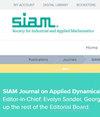视觉麦凯效应数学模型
IF 1.8
4区 数学
Q2 MATHEMATICS, APPLIED
引用次数: 0
摘要
SIAM 应用动力系统期刊》第 23 卷第 3 期第 2138-2178 页,2024 年 9 月。 摘要:本文研究了视觉感知与初级视觉皮层(V1)神经活动数学建模之间错综复杂的联系。重点是视觉麦凯效应建模[D. M. MacKay, Nature, 180 (1957), pp.]虽然分岔理论一直是解决神经科学问题的重要数学方法,尤其是在描述 V1 因参数变化而自发形成的模式方面,但它在具有局部感官输入的情况下面临挑战。例如,在麦凯的心理物理实验中,视觉刺激信息的冗余导致了不规则的形状,使得分岔理论和多尺度分析的效果大打折扣。为了解决这个问题,我们采用了一种基于 Amari 型神经场模型输入输出可控性的数学观点。在这一框架中,我们将感觉输入视为一种控制功能,即通过视网膜-皮质图谱捕捉视觉刺激的明显特征的皮质表征。这包括麦凯漏斗图案 "麦凯射线 "中心的高度局部化信息。从控制理论的角度,讨论了线性和非线性响应函数的 Amari 型方程的精确可控性。在视觉麦凯效应建模中,我们调整了代表神经元内部连通性的参数,以确保在没有感觉输入的情况下,大脑皮层活动以指数方式稳定在静止状态。然后,我们进行了定量和定性研究,以证明它们捕捉到了麦凯报告的诱导残像的所有基本特征。本文章由计算机程序翻译,如有差异,请以英文原文为准。
A Mathematical Model of the Visual MacKay Effect
SIAM Journal on Applied Dynamical Systems, Volume 23, Issue 3, Page 2138-2178, September 2024.
Abstract.This paper investigates the intricate connection between visual perception and the mathematical modeling of neural activity in the primary visual cortex (V1). The focus is on modeling the visual MacKay effect [D. M. MacKay, Nature, 180 (1957), pp. 849–850]. While bifurcation theory has been a prominent mathematical approach for addressing issues in neuroscience, especially in describing spontaneous pattern formations in V1 due to parameter changes, it faces challenges in scenarios with localized sensory inputs. This is evident, for instance, in MacKay’s psychophysical experiments, where the redundancy of visual stimuli information results in irregular shapes, making bifurcation theory and multiscale analysis less effective. To address this, we follow a mathematical viewpoint based on the input-output controllability of an Amari-type neural fields model. In this framework, we consider sensory input as a control function, a cortical representation via the retino-cortical map of the visual stimulus that captures its distinct features. This includes highly localized information in the center of MacKay’s funnel pattern “MacKay rays.” From a control theory point of view, the Amari-type equation’s exact controllability property is discussed for linear and nonlinear response functions. For the visual MacKay effect modeling, we adjust the parameter representing intra-neuron connectivity to ensure that cortical activity exponentially stabilizes to the stationary state in the absence of sensory input. Then, we perform quantitative and qualitative studies to demonstrate that they capture all the essential features of the induced after-image reported by MacKay.
Abstract.This paper investigates the intricate connection between visual perception and the mathematical modeling of neural activity in the primary visual cortex (V1). The focus is on modeling the visual MacKay effect [D. M. MacKay, Nature, 180 (1957), pp. 849–850]. While bifurcation theory has been a prominent mathematical approach for addressing issues in neuroscience, especially in describing spontaneous pattern formations in V1 due to parameter changes, it faces challenges in scenarios with localized sensory inputs. This is evident, for instance, in MacKay’s psychophysical experiments, where the redundancy of visual stimuli information results in irregular shapes, making bifurcation theory and multiscale analysis less effective. To address this, we follow a mathematical viewpoint based on the input-output controllability of an Amari-type neural fields model. In this framework, we consider sensory input as a control function, a cortical representation via the retino-cortical map of the visual stimulus that captures its distinct features. This includes highly localized information in the center of MacKay’s funnel pattern “MacKay rays.” From a control theory point of view, the Amari-type equation’s exact controllability property is discussed for linear and nonlinear response functions. For the visual MacKay effect modeling, we adjust the parameter representing intra-neuron connectivity to ensure that cortical activity exponentially stabilizes to the stationary state in the absence of sensory input. Then, we perform quantitative and qualitative studies to demonstrate that they capture all the essential features of the induced after-image reported by MacKay.
求助全文
通过发布文献求助,成功后即可免费获取论文全文。
去求助
来源期刊

SIAM Journal on Applied Dynamical Systems
物理-物理:数学物理
CiteScore
3.60
自引率
4.80%
发文量
74
审稿时长
6 months
期刊介绍:
SIAM Journal on Applied Dynamical Systems (SIADS) publishes research articles on the mathematical analysis and modeling of dynamical systems and its application to the physical, engineering, life, and social sciences. SIADS is published in electronic format only.
 求助内容:
求助内容: 应助结果提醒方式:
应助结果提醒方式:


